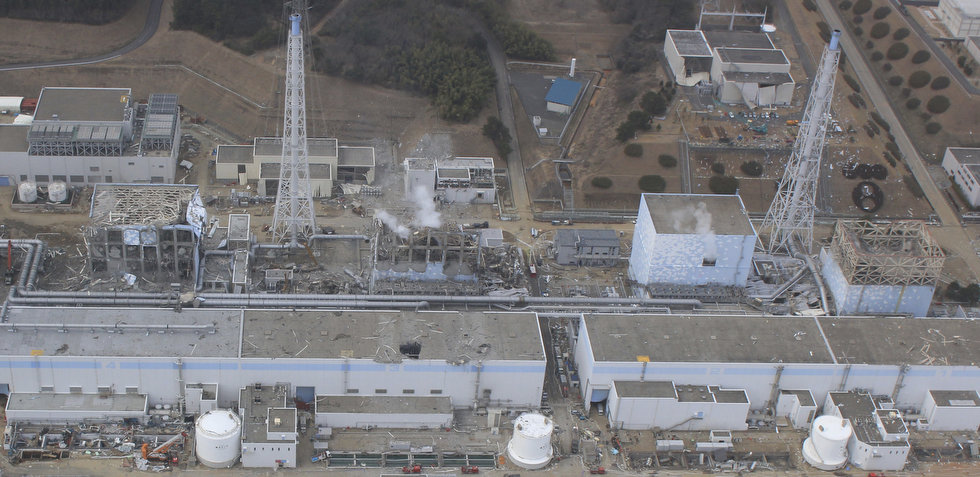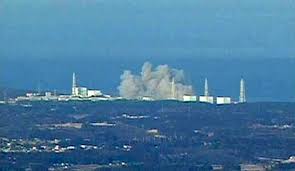 Today is, in case anyone forgot, the fourth anniversary of the beginning of the seemingly endless Fukushima nuclear disaster.
Today is, in case anyone forgot, the fourth anniversary of the beginning of the seemingly endless Fukushima nuclear disaster.
Four years later, hundreds of thousands of people are still displaced from their homes and previous livelihoods; hundreds of tons of radioactive water continues to leak from the reactor site into groundwater and the Pacific Ocean; radioactive waste continues to pile up on the reactor site and surrounding communities–where it likely will stay for decades if not centuries; and there even remains some uncertainty about the exact location of the most lethally radioactive material–the molten fuel cores from the melted reactors. How far down did the molten fuel flow? Did it move horizontally? What further dangers does it pose now, and in the decades of clean-up to come? We don’t know, and neither do Japanese officials.
We’ve posted a number of new materials on the Fukushima page of NIRS’ website, including new reports and presentations from SimplyInfo.org, and Japan’s Green Action, Peace Boat and Citizens Nuclear Information Center. Check them out here, they are all worthwhile.
And we’ve also posted an audio file of NIRS’ March 9 telebriefing on the situation at Fukushima from Akira Kawaski of Peace Boat, the prospects for a continued shutdown of Japan’s reactors by Aileen Mioko Smith of Green Action, and the effects of Fukushima on nuclear regulation here in the U.S. from David Lochbaum of Union of Concerned Scientists.
Because David’s presentation was marred by some apparent wi-fi glitches, he has graciously provided the notes–and some graphics–he used to prepare his presentation and they are available on the Fukushima page as well.

Four years later, some have clearly learned the lessons of Fukushima–most notably Germany which continues on its successful Energiewende energy transition to a clean energy future. Many nuclear power advocates try, in various ways, to put down that transition for not having yet met all its promises. The reality is that it is, in fact, a transition, one that takes years to implement and is working better than its proponents might have hoped and far better than its detractors claim.
When I participated in protests against radioactive waste transport in Gorleben and Ahaus, Germany in the late 1990s, then Interior Minister Angela Merkel was the enemy and prime target of many of the protestors. Her support for the nuclear industry and its efforts to dump its wastes, at just about any cost (literally, each shipment cost about $100 million, much of it for the 30,000 police that were mobilized to prevent the demonstrators from disrupting the shipments) on farming communities in northern Germany was readily apparent. You can read my account of these protests here (at the bottom of the page), along with some contemporaneous accounts from German activists.
But now, even she has changed her tune and is solidly in the mainstream of German public opinion, which opposes nuclear power by stratospheric proportions. Last week, Merkel was in Japan and urged the government not to restart its reactors, but instead to join Germany in creating a new clean energy economy.
That’s progress. So is the stunning drop in costs for renewable energy, especially solar power, over these same four years, and the corresponding increases in its efficiency that have made renewables a viable source to power a modern industrial nation like Germany and Japan.
And the United States.
Our progress is much slower, and we have to fight non-stop against the nuclear and fossil fuel industries which profit from poisoning our people and planet. But we are progressing nonetheless. Last year, renewables provided 13.4% of our nation’s electrical generation. And that’s a number that’s going to just keep growing and growing. Our job is to accelerate that transition as fast as possible. That’s the lesson we must take from that terrible tragedy that began four years ago today and continues without end.
Michael Mariotte
March 11, 2015
Permalink: https://www.nirs.org/fukushima-four-years-on/
Your contributions make publication of GreenWorld possible. If you value GreenWorld, please make a tax-deductible donation here and ensure our continued publication. We gratefully appreciate every donation of any size.
Comments are welcome on all GreenWorld posts! Say your piece. Start a discussion. Don’t be shy; this blog is for you.
If you’d like to receive GreenWorld via e-mail, send your name and e-mail address to nirs@nirs.org and we’ll send you an invitation. Note that the invitation will come from a GreenWorld@wordpress.com address and not a nirs.org address, so watch for it. Or just put your e-mail address into the box in the right-hand column.
If you like GreenWorld, help us reach more people. Just use the icons below to “like” our posts and to share them on the various social networking sites you use. And if you don’t like GreenWorld, please let us know that too. Send an e-mail with your comments/complaints/compliments to nirs@nirs.org. Thank you!
GreenWorld is crossposted on tumblr at https://www.tumblr.com/blog/nirsnet




Michael, Thanks for links to your Fukushima page. The tsunami anniversary was featured on Germany’s “Journal” program, yet nothing was said about Ms. Merkel’s changed mind on nuclear power. Not only does TEPCO issue public denials of all sorts in their propaganda campaigns about the Daiichi reactors, but among the worst human consequences of this fiasco is that many Japanese parents with children, and elderly persons, are still living in temporary housing.
Until 2011, Japan had the 2d largest world economy (today it is China). The Japanese government still has the nerve to claim that it is “safe” to return to former housing in Fukushima area, despite the fact that the region is so severely contaminated that only a few old folks remain there. Basically it is a deserted area. Former homes are either in total ruins or already dozed under. What a shocking comment on the Japanese government that they have not within the past three years provided habitable living conditions for the displaced Fukushima people.
The nightmare that will not end in my life time. “It’s a can of tuna” “It a glow stick” “It’s a can of tuna you can eat in the dark”. Except it’s really not that funny is it.